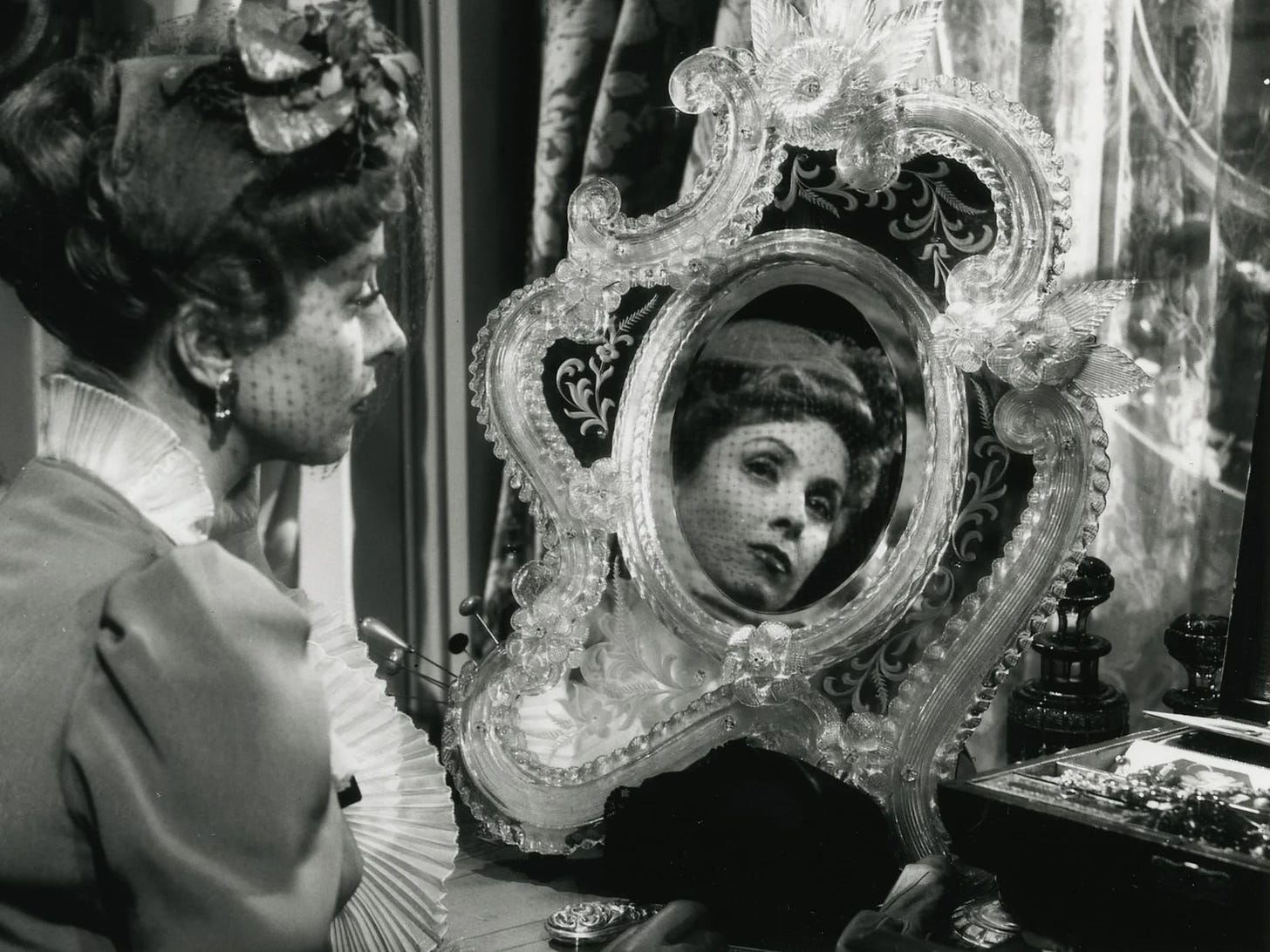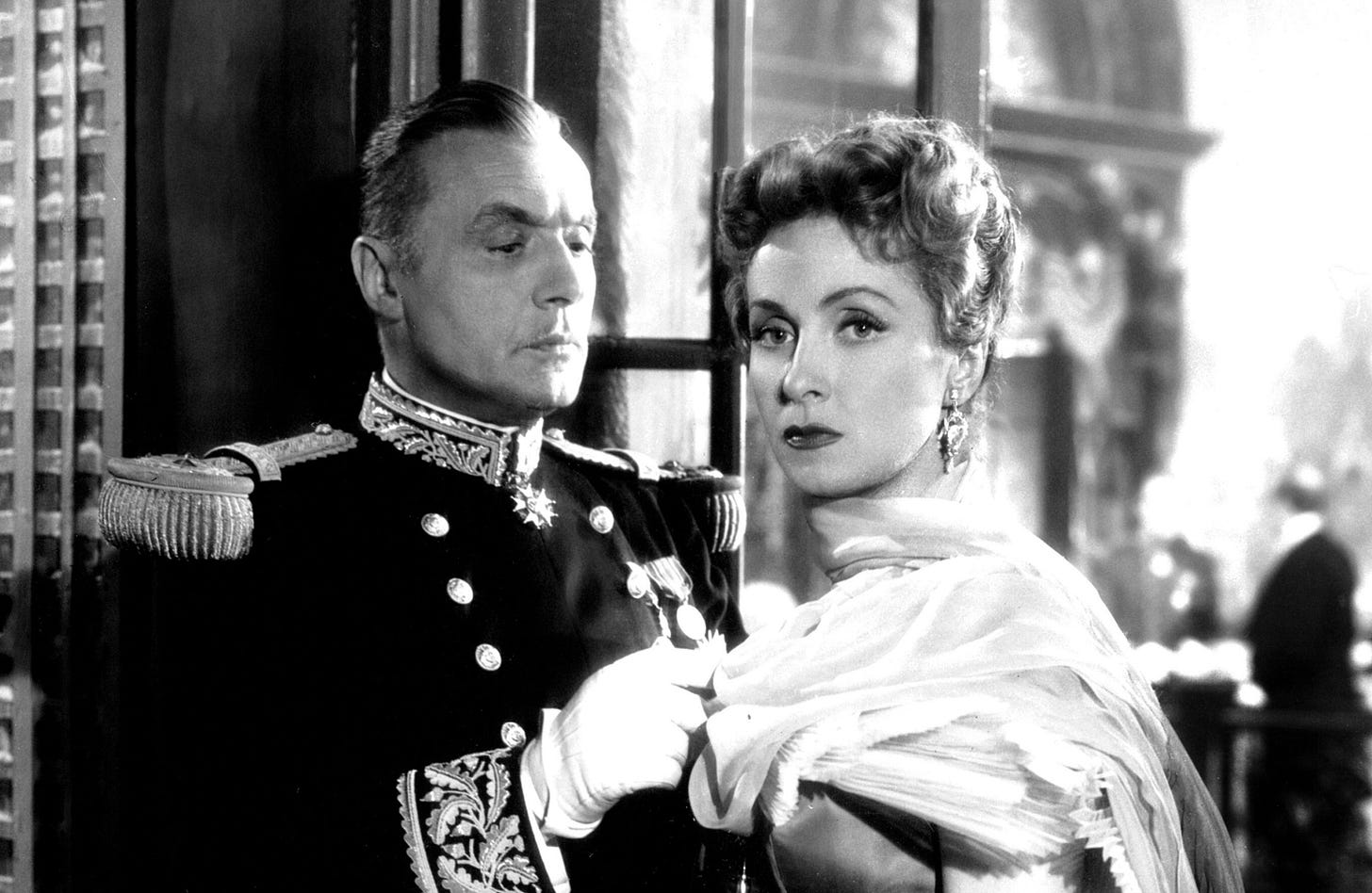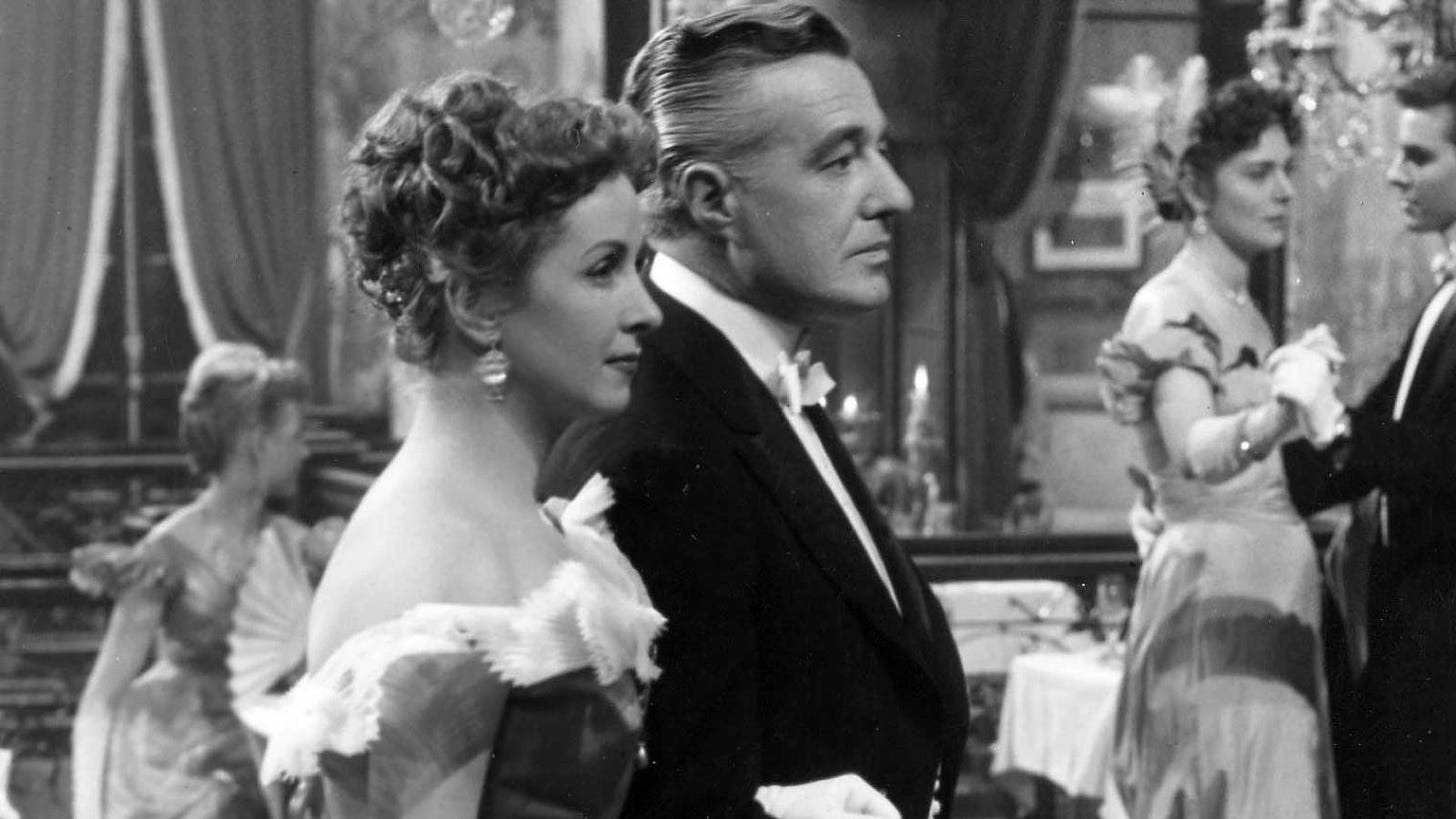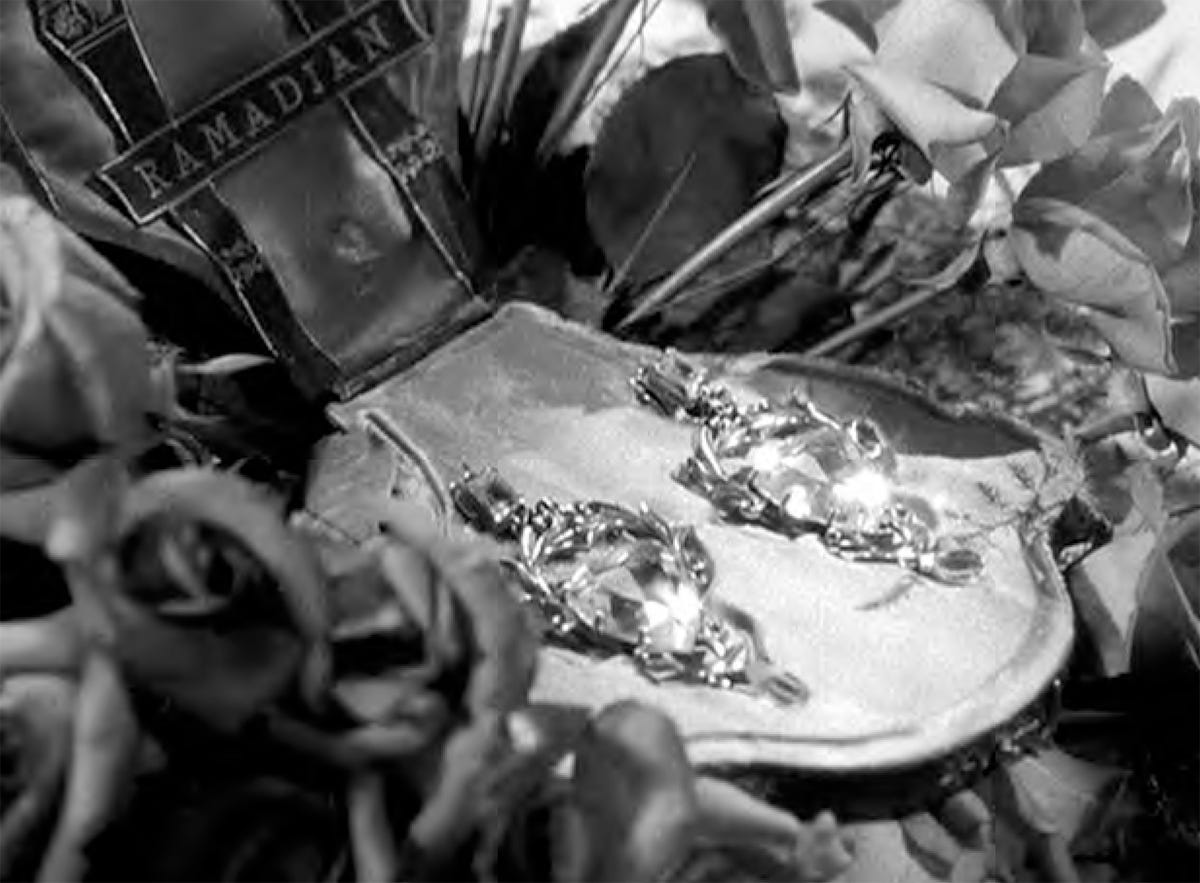#90 (tie): ‘The Earrings of Madame de…’: The Reveal discusses all 100 of Sight & Sound’s Greatest Films of All Time
Biting yet swooningly romantic, Max Ophüls' stylish heartbreaker resists easy categorization.
The Earrings of Madame de… (1953)
Dir. Max Ophüls
Ranking: #90 (tie)
Previous rankings: #93 (2012), #70 (2002)
Premise: In fin de siècle Paris, the aristocratic Madame de… (Danielle Darrieux) —her full name is coyly elided throughout the film — has spent freely and fallen into debt, prompting her to sell a pair of valuable earrings that her military commander husband André (Charles Boyer) gave to her as a wedding gift. This kicks off a chain of events as the earrings pass first back to André then to André’s mistress Lola (Lia Di Leo) then, via Constantinople, to the handsome Italian diplomat Fabrizio Donati (Vittorio de Sica), who uses them as part of an attempt to woo Madame de…. His success has unexpected consequences.
Keith: The follow-up to the successful La Plasir and the third of four films the German-born Max Ophüls made in France after returning from a stint in Hollywood before dying at the age of 54, The Earrings of Madame de… adapts a 1951 Louise de Vilmorin novel simply entitled Madame de. In fact, it was released as Madame de… in France and it appears under that shorter title on the Sight & Sound list. But I like The Earrings of Madame de… better, in part because it’s a film about how the meaning of those earrings keeps shifting over time.
As the film opens, their value is purely monetary. They’re an expensive bauble Madame de… can use to bail herself out of trouble. When André, after reacquiring them without Madame de…’s knowledge, gives them to Lola, they become a symbol of how devalued André’s marriage to Madame de… has become. They get along but sleep in separate beds, albeit beds within shouting distance of one another. When Donati gives them to Madame de…, however, they take on a new sort of value. And, as the film ends, they’re almost literally enshrined, having been given away in a futile act of piety. Critic Molly Haskell has described Ophüls’ films as being “given over to the contemplation of love in all its permutations,” and the meaning of the jewels shifts to match the sort of love they’re embodying. It’s very much a movie about its three central characters, but the earrings have a character arc all their own.'
Circling back to that “love in all its permutations” idea, we should talk about what’s covered here. The Earrings of Madame de… is set in a level of high society in which love is never treated particularly seriously until it becomes deadly serious, as in the film’s final moments. Madame de… is a known flirt. In some ways, society demands her to play that part. It’s an expectation, but one coupled to another expectation: that she never takes it too far. I think it’s easy to surmise that Madame de… has never really been in love before meeting Donati. The impulse leads her to see beyond the frivolous world around her, allowing her to become a more soulful person. But it also seals her doom.
That’s later, of course. Before then, the film offers images of glamour and excess captured by a camera that almost never stops moving. That’s, of course, Ophüls trademark and one that’s made him a favorite of Paul Thomas Anderson and other directors who favor restless camerawork and technical precision. So let me start by asking your thoughts on this: How does the Ophüls style serve his subject here?
Scott: The Ophüls style serves his subject in different ways at different times, but I think in the early going, it reinforces the urgency felt by Louise—I’m inclined to go with Madame de…’s first name to keep from ellipses abuse—as she hocks this pair of diamond earrings in order to climb out of debt. (More on the significance of her thinking in a moment.) The one standout shot that comes to mind here is when Louise tracks down the soon-to-be-very-busy jeweler Rémy (Jean Debucourt) to make the offer and the camera tracks them walking together before craning up a set of spiral stairs leading to his office. The entire sequence, starting with Louise sneaking out of the house and praying to the saints before meeting with Rémy requires speed and a little desperation on her part, and we can see how a roving camera underscores that restlessness. (Paul Thomas Anderson would magnify this effect tenfold in films like Magnolia and Punch-Drunk Love, which move ceaselessly.)
The second moment when I was particularly conscious of the camerawork is that lovely sequence when Louise dances with Donati, which not only involves movement but a kind of invisible transition from one party to the next, finally ending at the two of them as the last ones on the dance floor. Ophüls’ camera gives you the visceral sensation of falling in love, of being swept off your feet. That comes from an unspoken, choreographed rhythm of two people in perfect step with each other, which the camera reinforces as an invisible third party. The two share dialogue leading up to the dancing, of course, but I’d argue that the passion between them is evoked mostly through cinematic means. We can feel a connection being made without having to establish it in words.
(As an aside, before leaving the style question, the shot of Louise tossing the torn-up letter pieces out a train window and those pieces transitioning into snow… My god. That’s cinema, folks.)
Now to get back to the earrings themselves, the central fascination of this film is how these pretty baubles that get passed around change in significance depending on the circumstances—they are as much mood rings as earrings. Ophüls establishes quite efficiently how Louise feels about Andre at the beginning through how she assesses these earrings, which were given to her as a wedding present. There are other things she possesses that she can sell, like her fur coats, but we hear her thinking that she’s “too fond of them” to let them go. Of course later, she will indeed sell these same coats to buy back the earrings, so it’s telling that she can bring herself to part from a gift that you’d think would be quite personal. To Louise, the logistics of selling the earrings without her husband knowing and inventing a persuasive story about losing them are what’s clouding her mind. She doesn’t feel that guilty about doing it.
It’s fascinating to me that the two other women who wind up in possession of the earrings—first Andre’s mistress and much later a niece who’s just had her first child—sell them back for the exact same reason. All three women are in debt and the money they get back from selling the jewelry is more meaningful than the gift. (Incidentally, I love how Rémy winds up being the broker for this deal on four different occasions. It’s like a deft bit of screwball comedy that Ophüls throws in to lighten up the mood.)
Of course, when Donati picks them up in Constantinople after Andre’s mistress sells them and offers them to Louise as a gift, the gesture is so moving to her that she winds up sacrificing everything as a result. She could just wear them surreptitiously when she’s with Donati or when Andre is out of sight, but she spins another disastrous web of lies because she wants them hanging from her ears at all times. (After a period spent apart, she tells Donati that the earrings were a comfort to her. “Thanks to them,” she says, “you were always at my side.”)
Swoon.
Did you find this film as romantic as I did, Keith? And what do you think of the use of this one object as an organizational tool for the entire film? And we should talk about these characters, too, because they’re complex and motivated quite a bit by the social mores of the period. I think we could understand Andre, for example, as a cold and callous villain, but I’m not ready to toss him entirely in the garbage.
Keith: I don’t want to cut André too much slack because some of his actions are clearly not-so-great and if there’s an author to the double tragedy that concludes the film beyond abstract concepts like “fate” and “society,” it’s André. But André can be charitably read as a man very much of his time and station and not a particularly foul example of such, either. He has a mistress (presumably not his first or last) and his marriage to Louise is more companionable than passionate, but it’s not like that was an unusual arrangement. And it is a companionable marriage. Andre seems to like Louise and he’s even tolerant of her deceptions until they become impossible to ignore. And, besides, he’s played by Charles Boyer. He’s as charming as they come, even when playing an outright villain like in Gaslight.
As the film opens, they seem like a couple living within the expectations of their social sphere. He cheats, discreetly. She flirts, indiscreetly, but never takes it any further. Both are playing at love while coloring within the lines dictated by their social sphere. It’s a very different movie, but I found myself thinking of Dangerous Liaisons and, as in Dangerous Liaisons, it’s genuine, overwhelming passion that throws everything off balance. When Louise finds herself in love — really, truly in love — for the first time after falling for Donati, it’s like something short circuits in her brain. (And, just on a physical level, who can blame her? De Sica is way too handsome to also be one of the most important directors who ever lived.)
Or, maybe more aptly, she’s feeling the feelings she should have felt all her life for the first time. Darrieux was in her mid-30s when she made this movie, which certainly isn’t old, but she’s not an ingénue anymore and she’s not playing one here. (Incidentally, Darrieux lived many years after this film’s release, dying in 2017 at the age of 100.) Louise is someone who, it’s safe to say, has had a sheltered, prescribed existence, one designed to keep messy feelings at bay.
That said, is Donati the villain of the piece? I mean, he knows how much trouble he’ll cause by pursuing Louise once she knows who she is, right? I think the real answer is it’s a film without villains, but I am curious as to when he falls for Louise. His machinations to get close to her when their paths first cross feel a bit practiced. He’s been down this road before with other women, I would venture, but is there a point where it becomes something more than a game for him?
Scott: He might be! To circle back to André, I think our instinct (certainly my instinct) is to sympathize wholly with Louise in this situation—her suffering in a loveless marriage, the first love that makes her feel alive before being cruelly extinguished, the symbolic and finally tragic fate of those earrings. But I think Haskell’s Criterion essay makes an eloquent argument for André’s perspective, this graf in particular:
Yet even as we sympathize with her, we take in Boyer’s barely spoken agony as the count. This military man, so used to hiding his feelings and having control, urges his inconsolable wife back to health with a desperate cheer, his wit, his concern, his love—all lost on her. Their divided bedroom, in which they call to each other from separate spaces—cavernous but luxurious—beautifully renders the nature of their marriage, the way they have forced each other into formal roles now only tragedy can shatter.
Shortly after André and Donati are introduced to each other, André describes his wife as “an incorrigible flirt” and “an expert at dashing a man’s hopes.” He’s embarrassed by the first part, but willing to tolerate it. It’s the second part that he counts on. When you think about how André knows about the deception with the earrings for so long without saying anything to her, it seems almost sadistic, like he’s toying with her. But, as you say, it’s a “companionable” marriage, and it seems, in their bedtime routine, that there’s a tacit understanding of its limits. It’s only when Louise falls in love with Donati and the hurt and humiliation of that affair becomes too much for André to ignore, those limits are breached and he takes action.
Let’s spare a thought, too, to André’s mistress Lola, who accumulates debts (from gambling) just like Louise does and also hocks the earrings to pay them off. You wonder a little about the depth of Lola’s feelings for André, which may be close to Louise’s, given her decision to pawn jewelry to which she probably doesn’t feel emotionally attached. Yet André’s affair with Lola and Donati’s affair with Louise are one of the film’s narrative rhymes, which Ophüls orchestrates as elegantly as the throughline with the earrings. We get the sense of how casually men like André and Donati can enter into these relationships as a privilege of status, and how little control the women have over their own fate. They are so bound by social mores and so lacking in agency that Louise habitually turns to a fortune teller to suggest where her life might be headed. Goodness knows it’s out of her hands.
But I’d stop short of considering Donati the villain of the piece, much as De Sica keeps his character’s feelings close to the vest. When Louise is off in Italy, Donati writes her love letters ceaselessly, which certainly suggests his investment in their relationship. And he ultimately dies as a result of it, though that’s nothing he could have anticipated. I like the idea of Madame de… being a film without villains, because it means that the very human motives of its characters have been thoroughly thought-through, and the tragedy of their interaction feels inevitable rather than engineered. (Though Ophüls is certainly a master at engineering.)
Any standout moments for you, Keith? I’ve already mentioned a couple of the more famous sequences—the letter pieces turning to snow, the dancing through multiple parties, etc.—but I’m stuck on the idea of Louise’s need to wear the earrings that Donati has given her, even though it puts her in terrible risk. She has to make up another silly lie about finding them in a pair of gloves, and of course it’s especially excruciating because we know that André has been on to her from the start. But there she is, out in public with the earrings on, because they mean so much to her now. That’s how jewels become precious.
Keith: The standout moment for me technically—and emotionally, now that I think about it—is the end of the famous dance sequence, when Louise and Donati are the last at the dance. The way Ophüls stages it, sometimes focusing on our central characters (who we see both directly and in a mirror), sometimes on the band as it packs up and the servants snuff out the candles, is so exquisitely fluid and the mood so romantic but with a hint of desperation. These are people who can’t let go of each other no matter what’s going on around them. That kind of passion comes at a price. That sense connects, too, to your observations about Louise’s insistence on wearing the earrings in public. She’s a character defined by her “white lies,” but this is her way to be her true self in public.
As for other moments, the finale is remarkable. The film’s bittersweetness takes an inevitable but nevertheless jarring dark turn. Instead of the carefully cultivated, mostly indoor spaces of the film until we’re in the wilderness where the rules of polite society don’t apply (even if dueling has its own rules). We never see Donati’s death but we don’t have to. Louise’s habit of swooning, which she’d previously brought out for dramatic effect, becomes real. The story was always heading to something like this, but it’s still a shock to get there.
Scott, before we leave the world of Madame de… any last thoughts? And does its slippage concern you?
Scott: I agree that Louise’s fainting spells, another running motif in the film, pay off in that moment where she hears André’s gunshot off in the distance and knows Donati has been killed since she doesn’t hear another. André has a habit of brushing off her fainting incidents because they happen so often and seem a reflection of her weakness and neediness. But it’s a lovely way to bring across Donati’s death—which, let’s face it, is only meaningful to us because it’s meaningful to her.
I guess my overall thought is what a perfect film Madame de… is. You admire Ophüls’ impeccable style and how the tiny gear-pieces of the narrative click together. (That wouldn’t be the case with Ophüls’ famously wounded follow-up, Lola Montes, but if anything, I adore that film even more.) As we continue to move through this list, I’m trying to become more sanguine about the classics that seem to be falling off, which may be because they’re not in fashion (or decent circulation) anymore, but is also a natural result of more candidates added to the mix every 10 years. I’m personally a bit stodgy when it comes to adding new films to the list, but I suppose if a film is an instant classic, maybe we should have the confidence to acknowledge it right away. Speaking of which…
Next: Parasite (2019)
Previous entries:
#95 (tie): Get Out
#95 (tie): The General
#95 (tie): Black Girl
#95 (tie): Tropical Malady
#95 (tie): Once Upon a Time in the West
#95 (tie): A Man Escaped
#90 (tie): Yi Yi
#90 (tie): Ugetsu









Is everyone still catching up with this? There's a lot to talk about with this one!
Wonderful commentary. I think in the strictly ordered haute-bourgeois world that Ophuls shows us, with its "rules of the game," a grand passion is catastrophic -- for all. We almost see the characters, especially Louise, shrink into shadows of themselves before dying.